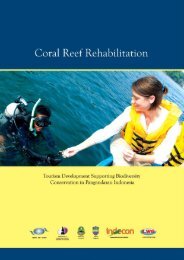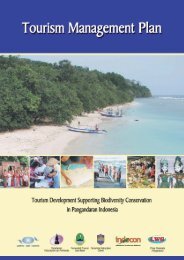Review of Laws and Regulation - unwto
Review of Laws and Regulation - unwto
Review of Laws and Regulation - unwto
- No tags were found...
You also want an ePaper? Increase the reach of your titles
YUMPU automatically turns print PDFs into web optimized ePapers that Google loves.
Compilation <strong>and</strong> <strong>Review</strong> <strong>of</strong> <strong>Laws</strong> <strong>and</strong> <strong>Regulation</strong>s in IndonesiaCompilation <strong>and</strong> <strong>Review</strong> <strong>of</strong> <strong>Laws</strong> <strong>and</strong> <strong>Regulation</strong>s in Indonesiagovernment is responsible to encourage communityparticipation through various activities in the field <strong>of</strong>forestry that are beneficial <strong>and</strong> pr<strong>of</strong>itable.b. Identification measures to be taken to change/strengthen regulations as a basis to prepare newlawsIn principle laws <strong>and</strong> regulations are already inline with the objectives <strong>of</strong> sustainable tourismdevelopment. The absence <strong>of</strong> its implementationin tourism development at the moment, is because<strong>of</strong> the unavailability <strong>of</strong> successful examples <strong>and</strong> aguideline to realize the principles, foundations <strong>and</strong>objectives <strong>of</strong> tourism development in the field.Therefore, it is more important to develop <strong>and</strong>initiate the application <strong>of</strong> these measures <strong>and</strong>schemes effectively in order to implement theabove points in the guidelines for local tourismdevelopment. The next step is to document <strong>and</strong>disseminate these experiences widely in order forthem to be replicated <strong>and</strong> adapted widely.3.1.3 Issues Related to the Target <strong>of</strong> SustainableTourism Developmenta. <strong>Review</strong> <strong>of</strong> laws <strong>and</strong> regulations <strong>and</strong>/or restrictiveclauses related to the target <strong>of</strong> sustainabletourism developmentIn order to ensure that all sites which have receivedinternational recognition such as Ramsar or WorldHeritage or Biosphere reserves, receive the status<strong>and</strong> adequate legal protection as well as the support<strong>of</strong> the national government, the government <strong>of</strong>Indonesia has ratified the Ramsar Conventionthrough Presidential Decree No 48 <strong>of</strong> 1991 <strong>and</strong> theConvention <strong>of</strong> Protection <strong>of</strong> Cultural <strong>and</strong> NaturalHeritage sites through the Presidential Decree No.26 <strong>of</strong> 1989. In general, sites which possess importantbiodiversity at the national level such as nationalparks, nature reserves <strong>and</strong> preservation areas/marine conservation sites have received adequatestatus/legal recognition, have an operational plan<strong>and</strong> receive government support. The legal status<strong>and</strong> the basic functions <strong>of</strong> nature reserves <strong>and</strong>animal protection reserves, nature conservation,national parks, protected forests, are regulated inLaw No. 5 <strong>of</strong> 1990 on the Conservation <strong>of</strong> NaturalResources <strong>and</strong> their eco systems.In addition, Law No. 41 <strong>of</strong> 1999 on Forestry stipulatesthat the forests have three functions : conservation,protection <strong>and</strong> production (Chapter 6, par 1)based on their functions as conservation forest,protected forest <strong>and</strong> production forest (Chapter 20)Conservation forests including nature protectionsites – flora fauna reserves <strong>and</strong> nature preservationforest – national parks, protected forest, <strong>and</strong> naturetourism parks.According to Government <strong>Regulation</strong> No. 68 <strong>of</strong> 1998on Conservation <strong>and</strong> Protected Areas, these siteshave to be managed based on a management plan(Chapter 12) which was drafted based on ecological,technical, economical, socio-cultural studies <strong>and</strong>contain objectives <strong>of</strong> management (Chapter 14<strong>and</strong> 36) Forest planning <strong>and</strong> the drafting <strong>of</strong> aforest management plan, the utilization <strong>of</strong> forestsare regulated in more detail in the Government<strong>Regulation</strong> No. 6 <strong>of</strong> 2007 on Forest Planning , thecompilation <strong>of</strong> a forest management plan <strong>and</strong> theutilization <strong>of</strong> forests.Sites with high international <strong>and</strong> national valuesare under the responsibility <strong>of</strong> the Department<strong>of</strong> Forestry <strong>and</strong> therefore the implementation <strong>of</strong>the laws is the responsibility <strong>of</strong> the Department <strong>of</strong>Forestry <strong>and</strong> its units in the field. Sites which havean environmental <strong>and</strong> biodiversity value are theresponsibility <strong>of</strong> the local government (provincial,regional, sub regional or operators) <strong>and</strong> both theWest java provincial government <strong>and</strong> the regionalgovernment in Ciamis have a Forestry Unit undertheir supervision.The status <strong>of</strong> marine conservation sites is that theirfunctions <strong>and</strong> regulations are governed separatelyin Law No. 27 <strong>of</strong> 27 on the Management <strong>of</strong> CoastalAres <strong>and</strong> Small Isl<strong>and</strong>s. These regulations contain thefollowing provisions for the conservation <strong>of</strong> coastalareas <strong>and</strong> small isl<strong>and</strong>s as follows:• Manage the preservation <strong>of</strong> coastal ecosystems<strong>and</strong> small isl<strong>and</strong>s• Protect the migration flow <strong>of</strong> fish <strong>and</strong> othermarine biota.• Protect <strong>of</strong> the habitat <strong>of</strong> marine biota.• Protect traditional culture heritage sites.The decision on the conservation <strong>of</strong> a coastal or smallisl<strong>and</strong> sites is made by the Minister <strong>of</strong> Marine Affairs<strong>and</strong> Fisheries while its implementation lies with theCentral <strong>and</strong> regional governments (Chapter 28).The above law also stipulates that the management<strong>of</strong> coastal areas <strong>and</strong> small isl<strong>and</strong>s with regard toits planning, utilization, supervision <strong>and</strong> control<strong>of</strong> interaction with humans who take advantage<strong>of</strong> these sites need to follow a natural process <strong>of</strong>sustainability to increase the welfare <strong>of</strong> the people<strong>and</strong> to maintain the wholeness <strong>of</strong> the Republic<strong>of</strong> Indonesia as a United State (Chapter 5). Theimplementation plan <strong>of</strong> coastal areas <strong>and</strong> smallisl<strong>and</strong> sites should consist <strong>of</strong> Strategic Planning,Zoning plans, <strong>and</strong> an implementation/operation plan.These conservation sites are known as RegionalMarine Conservation Sites (KKLD), as decreed bythe Minister <strong>of</strong> Marine Affairs, yet the authority forimplementation lies with regional governments.The Ciamis Regency itself has followed up onthese regulations by deciding on a Reserve MarineConservation location in the Ciamis Regency througha Decree <strong>of</strong> Head <strong>of</strong> the Regency <strong>and</strong> covers thelowest low tide coastal area up to 4 miles. Marinemanagement <strong>and</strong> control in the Ciamis Regency istherefore the responsibility <strong>of</strong> the local Marine <strong>and</strong>Fishery unit.These regulations indicate that the authority forthe management <strong>of</strong> conservation areas, both onl<strong>and</strong> <strong>and</strong> on the sea having a high biodiversityvalue, protection function <strong>and</strong> high support <strong>of</strong>livelihood systems is usually with the government,<strong>and</strong> consequent operation costs become a burdento the government which only has limited economicresources. In fact many <strong>of</strong> these conservation sitesalso have potential <strong>and</strong> can function as tourism sites<strong>and</strong> can contribute to conservation efforts.Income from tourism is categorized as Governmentincome outside tax income (on the utilization <strong>of</strong>resources). According to <strong>Regulation</strong> No. 20 on StateIncome outside Taxes <strong>and</strong> Government <strong>Regulation</strong>No. 2 on tariffs on Income outside taxes originatingfrom the utilization <strong>of</strong> forest areas for the benefit <strong>of</strong>development outside forestry activities need to beimmediately h<strong>and</strong>ed over to the government c<strong>of</strong>fers.There is no further regulation on responsibilities<strong>and</strong> mechanism to allocate part <strong>of</strong> these funds forconservation activities.However, in the field <strong>of</strong> tourism, the new tourismlaw No. 10 <strong>of</strong> 2009 has regulated that the localgovernment is to allocate part <strong>of</strong> the incomefrom the operation <strong>of</strong> tourism for the benefit <strong>of</strong>nature <strong>and</strong> culture preservation (Chapter 59). Ina management <strong>of</strong> tourism based on principles<strong>of</strong> justice, efficiency, transparency <strong>and</strong> publicaccountability, the amount allocated should beknown to the public.Other than government institutions, there are nongovernmentorganizations - PPLH; KMPP- which showconcern for nature preservation, conservation <strong>of</strong>biodiversity <strong>and</strong> are very valuable in contributing tothe attainment <strong>of</strong> the target <strong>of</strong> sustainable tourism,<strong>and</strong> this is recognized in related to implementationregulation.b. Identification <strong>of</strong> legal regulations which, withsome additions/revisions will overcome theissuesBasically the legal system in Indonesia alreadysupports the targets <strong>of</strong> tourism that supports theconservation <strong>of</strong> biodiversity. The problem is the lack<strong>of</strong> underst<strong>and</strong>ing <strong>of</strong> the community as a whole <strong>and</strong>its law enforcement.c. Identification <strong>of</strong> the necessary measures to betaken to strengthen existing regulations as abasis to prepare for the drafting <strong>of</strong> new lawsNGOs in support <strong>of</strong> tourism based on theconservation <strong>of</strong> biodiversity need to be assisted withknowledge <strong>of</strong> existing regulations. Other governmentinstitutions have disseminated material <strong>and</strong>~ 10 ~~ 11 ~




